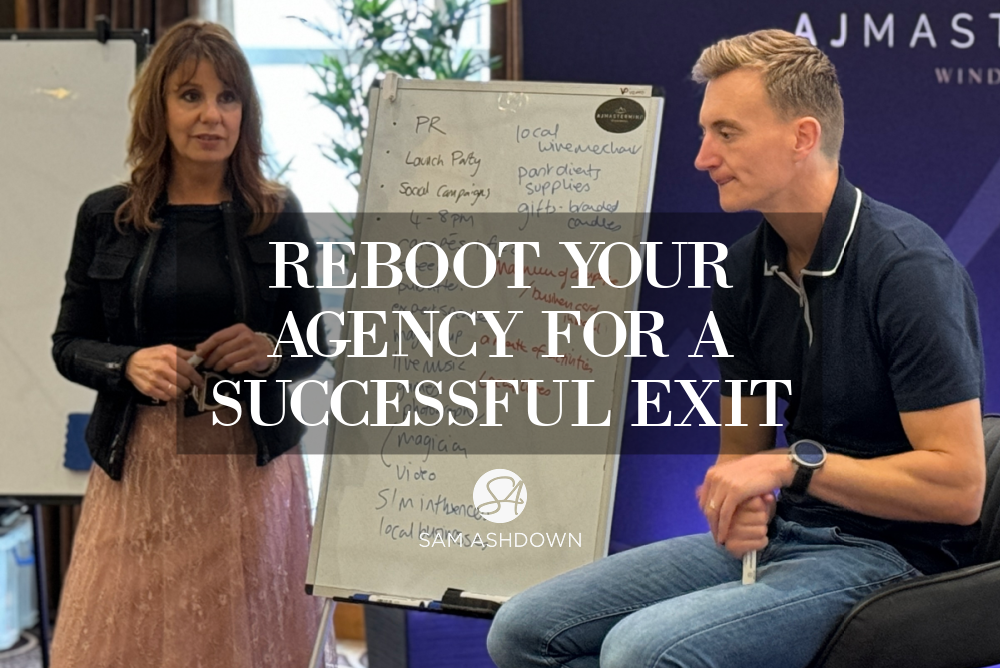Picture this: you’ve been running your agency for years, maybe decades. You’re feeling ready to retire, or at least to step back into a less active role. After all, you’ve earned the right to start taking it easy.
But there’s a problem; the business isn’t generating enough profit.

For some, it’s worse than that. They could be facing health challenges that leave little time to plan a successful exit from their business. Or they might employ family members who are reliant on the income the agency produces.
I know it can be hard, when you’re in your fifties or sixties, to find the motivation to take a new direction to kickstart your agency into profit. Looking back over the last few years, has your revenue flatlined? (Excluding Covid of course.) Or even declined?
You know things have to change, but how?
What I want to share with you in this article is what it takes to turn things around in a situation like yours. I’ll warn you, it’s not going to be easy. But without putting a strategy in place, you’re going to be faced with either selling your business for a fraction of its worth, or even simply closing your doors for the last time, and walking away.
Before you read on, I have an important question for you: are you prepared to do what it takes to re-activate your business?
Because if you are, and you put everything into making your business a success, the benefits are life-changing:
- You can retire comfortably, either by selling your business for the amount it’s worth, or by being able to take a less active role, and an income
- You can finally reap the reward of working all those evenings and weekends, of pouring your heart and soul into your business. It owes you.
- You can retire proud, knowing you did all you could to build your business to its full potential.
You didn’t come this far to only come this far – right?
The Reboot Your Agency Strategy
Here’s what we need to reboot:
1. Your business model – your target client, average completion value, fees and more
2. Your lead generation system – direct mail and social media
3. Your brand – brand positioning, visual brand, marketing assets including website
4. Your delivery – all your property marketing, including styling, photography, brochures etc
5. Financial control – cashflow, revenue predictor, targeting and metrics
Once you’ve done this, we can look at your Exit Plan and your wealth building strategy. To book a free 30-minute call with me to get a customised, simple plan, just tell me a bit about you and your agency here and we’ll get it booked in.
Ok let’s dive in:
1. Your business model
Are you a low-fee, high-volume agency, or a high-fee, low-volume agency?
Spoiler: there is no mid-fee, mid-volume model that works.
So, if we have to choose a side, we first need to look at our resources. Because when we plug in the lead generation system, you and your team need to be ready to handle the increase in business. If you have a small office, and a team of less than five, a high-fee, low-volume model is going to be much easier to manage.
Here’s what I suggest you aim for with each model:
Low-fee, high-volume – 100 sales at £3,000 = £300,000 turnover
High-fee, low-volume – 30 sales at £10,000 = £300,000 turnover
A £300,000 (sales-only) turnover agency model breaks down like this:
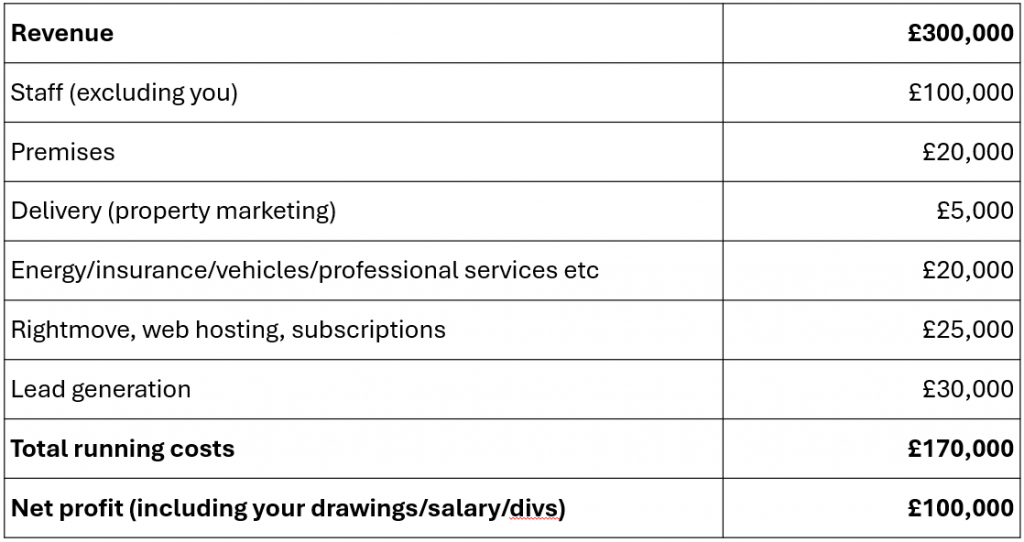
Of course, every business is different, but these figures are pretty typical of £300k agencies, taking lettings out of the equation.

Now let’s look at the fees you need to charge to make these two models work:
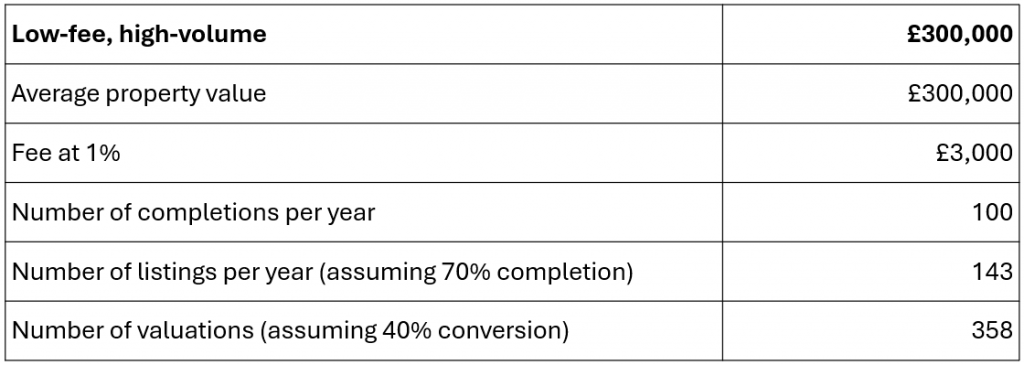
Or
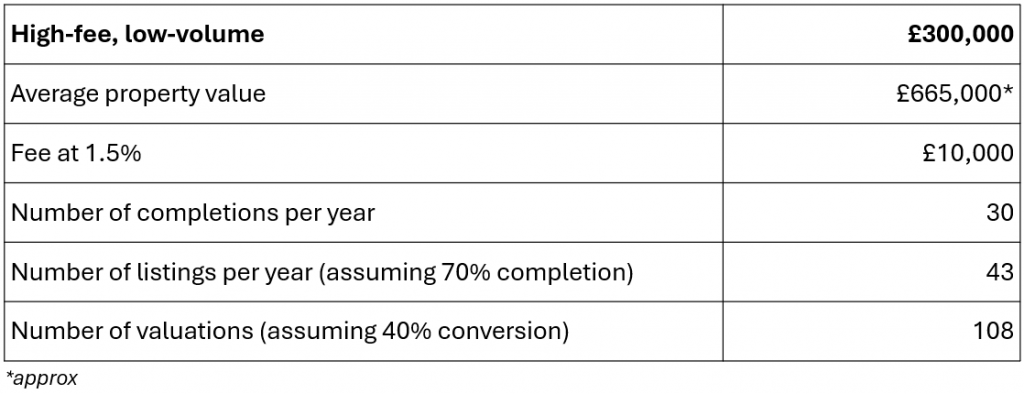
2. Your lead generation system
This is where the rubber meets the road to make sure the business model you’ve chosen actually works.
Social Media
Whilst social media is the proof of what you do and who you do it for, it doesn’t directly generate leads. This means that you need a target number of posts per week, but it won’t move the needle on your 358/108 valuations per year.
If you want to know more about how our social media formula works, check out this post here.
Direct Mail
The most predictable method of getting consistent leads is direct mail – by an absolute mile. No other form of marketing – not Meta or Google Ads – is as effective as a skilfully-written letter.
We use direct mail every day in our agency, AshdownJones, to create valuation opportunities in properties from around £400,000 to £10 million, and more. Our biggest fee, at £153,000, came from a series of direct mail letters, spanning 4 years.

Let’s look at the numbers, starting with the high-fee, low volume model:

With the low-fee, high-volume model, we can use leaflets instead of letters. We just need to send more of them, as they have a lower conversion to valuation rate.

In the P&L above, I’ve allowed £30,000 for lead generation, which should give you enough leeway to pay for either the letters or the leaflets, depending on which model you’ve chosen.
3. Your brand
You’ve chosen your business model and got your lead generation system dialled in. now it’s time to take a look at your brand, to make sure you’re able to attract the clientele you need.
If you’re aiming for the low-fee, high-volume model, your website needs to be simple, colourful and have an easy conversion funnel. Think Easyjet, Booking,com and Argos. Online valuation tools can work well for lead capture, and videos on your website and socials can walk your target client through the process of working with you.
The high-fee, low-volume model is more sophisticated. Colours and shapes need to be elegant, feel luxury, and in colours that represent quality brands. Think Montblanc, Asprey, The White Company. These brands portray quality over cheapness. Case studies work well for these vendors, who want to see social proof of sold properties similar to theirs.
It’s almost impossible to ‘stretch’ a brand. You can’t be the go-to agent for terraces and also for large barn conversions. Pick your market and focus on it, relentlessly.
If your current brand is more low-value than luxury, you could create an additional brand to complement your current brand, so that you create differentiation to justify your claims you can sell high-value homes. You’ve probably seen plus-brands like ‘Signature’, ‘Prestige’, ‘Premium’ and ‘Unique’ . By adding a plus-brand, you can keep your bread-and-butter revenue and at the same time gain a new prestigious brand.
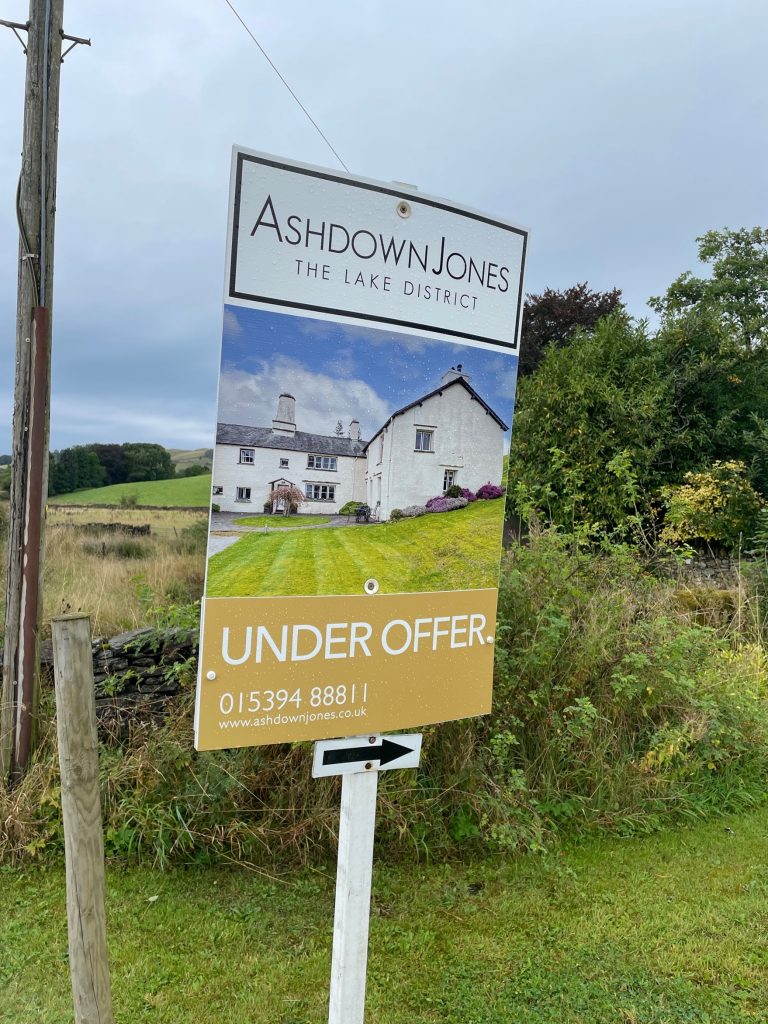
4. Your delivery
If your core market is flats, 2-bed terraces and 3-bed semis, you probably have your property marketing done in-house. With fees of £3,000 and less, you can’t really afford to use expensive photographers and brochure designers, much less print your brochures.
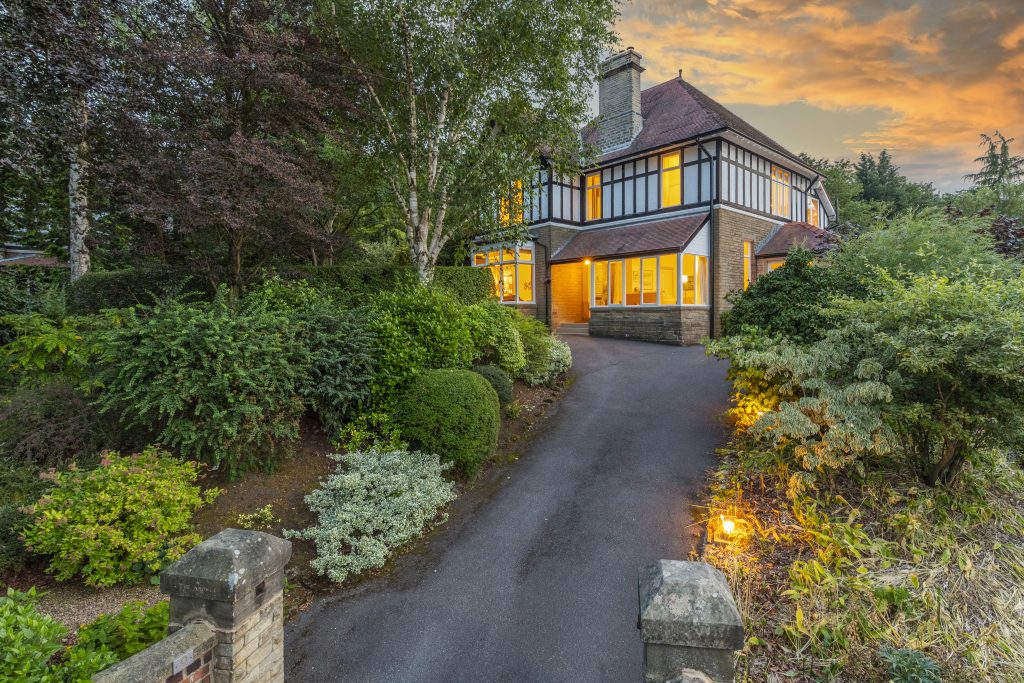
If you’re looking to uplevel, and take your fees to £10k and above, you have to have a property marketing system that really showcases your brand through the properties you sell. The main property marketing components to invest in are:
- Styling – including props, both inventory (eg cushions and lamps) and perishables (eg cake and flowers)
- Photography – local, lifestyle, drone and twilight
- Copywriting – with a vendor interview to add colour and context
- Bespoke boards – unique to each home
- Magazine-style brochures – 8-16 pages, printed in low runs
We have a system we call ’21 Days to Market’ in which each property marketing is treated like a standalone project, to make sure it has maximum impact on launch. Create your own system to reassure your clients of your expertise and process, and train your team to carry it flawlessly every time – and without you.

5. Financial control
At £300k turnover and above, if you don’t have full financial control, things start to go wrong. Like not paying the vat bill and getting a fine. Or running out of money and having to borrow to make payroll.
Full financial control gives you peace of mind and a more robust business. And it all comes down to the systems and tools you use. Here are the tools we can’t do without:
Cashflow forecast – checked daily, no huge fees added unless you’re certain they’ll complete. Forecast at least 6-9 months ahead.
Financial health dashboard – we keep this on a whiteboard in our office. It shows:
- Cash in bank
- Cash in vat account
- Guaranteed pipeline (exchanged)
- Banked year to date
Each of these items has a traffic light mark next to it – red, amber, green – depending on our tolerance levels. Eg if cash in bank is less than £50k, it’s a red for us.
Scorecard – on a whiteboard, and updated weekly, it shows:
- Letters sent
- Social posts
- Valuations
- Instructions
- Listed fees
- Average fee
- Pipeline (under offer)
We report on our Scorecard every Friday in the AJ Mastermind Facebook group – add yourself here.
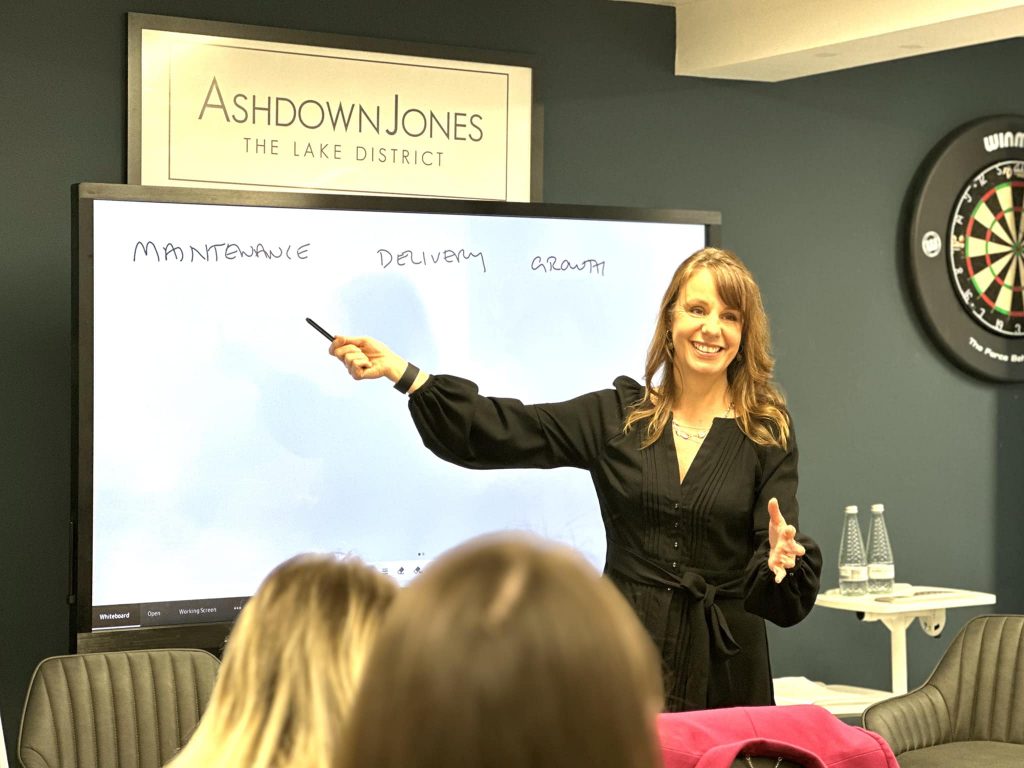
What to do next
I’ve given you a lot to digest here. And we haven’t even touched upon your team structure, recruitment, training, operations, sales progression…. The list is seemingly endless.
Each month I talk to a handful of agents to offer my thoughts and ideas of what they could do to grow their agency and improve their exit planning. These calls are free, and not salesy. I really want to help you, and a 30-minute call is a great kickstart. Just click this link and pop in your details – in just days, you could have your business plan clear and in place.
Sam



